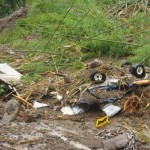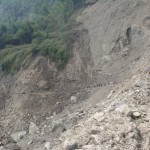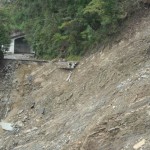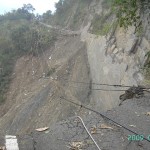TY Morakot seriously affected Lulin Obs.
Sep 12th

Landslide at Mt. Alishan area (by Mr. Hsiung from Lulin Obs.)
I got a sad email from Lulin Observatory's director Hung-Chin Lin on September 9 reporting Typhoon Morakot's destructions at central Taiwan and affectiveness at Lulin Observatory. Morakot, a Catagory-2 typhoon, hit Taiwan around August 8 and caused about 700 fatalities and a damage of $443,000,000. According to Lin, who quoted the report from local transpotation and electrical authorities, the only two roads to Lulin (Provincial Road No. 21 and No. 18, including electricity and communication lines) both suffered "very serious" damages due to lots of landslides along the way and a fully recover may require 1-2 years at least. The observatory staffs were stucked for 10 days at the observatory until being rescued by helicopters. Thankfully, the observatory itself does not suffer major damages, but Lin suggests it will take more than two months to get the telescope working again, and it may take at least a year to get things back to normal.
I have upload a few images of the road conditions, copyrighted by those who took them.
Updated Sept. 19: I noted Dr. Lakdawalla from the Planetary Society has monitored this post at her Twitter -- thanks for her attention. I may added a few introductions of Lulin Observatory for new-comers. Lulin Observatory is the only observatory in Taiwan that with fully operation on both research and education. It's also where Lulin Sky Survey (once had been the only asteroid program in East Asia/Western Pacific) and Taiwan-America Occultation Survey (TAOS) conducted. Astronomers should be familiar with one of its best-known discoveries -- Comet Lulin (the naked-eye comet in early 2009). I'm no longer with Lulin Sky Survey as it had been terminated about six months ago, but I do keep contact with the friendly faculties and staffs there since the excellent collaboration we made over the last three years and occasionary use the 1-m telescope there to do some research on asteroids. The newest report I got this weekend is that the observatory can be accessed by staffs again since an emergency way has just been completed.
- Destructed properties (by Mr. Hsiung from Lulin Obs.)
- Drown truck (by Mr. Hsiung from Lulin Obs.)
- Landslide on Provincial No. 18 (by Mr. Hsiung from Lulin Obs.)
- Landslide at Mt. Alishan area (by Mr. Hsiung from Lulin Obs.)
- Landslide on Provincial No. 18 (by Mr. Hsiung from Lulin Obs.)
- Provincial No. 18 way to Lulin (by Mr. Hsiung from Lulin Obs.)
- Provincial No. 18 way to Lulin (from Taiwan Transportation Authority)
- Provincial No. 21 way to Lulin (from Taiwan Transportation Authority)
- No. 162A Country Road damages (from Taiwan Transportation Authority)
A most recent photo of Comet Lulin
Jan 2nd
[Image Removed]
After discovered by Chi Sheng and me on July 11, 2007, Comet C/2007 N3 (Lulin) was brightening gradually as it approach to the sun. Now it is around 7 mag, shining on the east at dawn. If the prediction is right, it will be around 4 mag on late Feburary, marked as the brightest comet in the year (among the so far known).
This image was taken on the night of Jan. 1 by the 0.41-m reflector at Lulin Observatory (the instrument that used to discover the comet), a total of three images under Johnson B/V and Cousins R were later aligned and combined by myself, to create a "color" image. Two tails can be seen, as the one to right (the dust tail) is an anti-tail, caused by our observing angle. The streak on the left is a man-made satellite. The background stars look strange as the comet moves when taking the series of images.
As the discoverer, I'm feeling lucky to see the comet which I detect it first among the human beings, is now on a significant brightness. However, at the same time, I'm also reminded with such a story -- a teacher once asked his student, "which island is the biggest island before the discovery of Australia?" "Greenland." Some replied. "It's still Australia. Whether our human beings discovered it or not does not do anything to the fact that it's the biggest island on the Earth." I think, I was, simply, spotted the comet before anyone else, and that's all. I was just lucky. Anyway, I'll observe the comet in the next couple of weeks exactly -- maybe, just with a little bit extra excitation -- as others may do. Happy observing in the International Year of Astronomy, guys!



































最新评论 Recent Comments